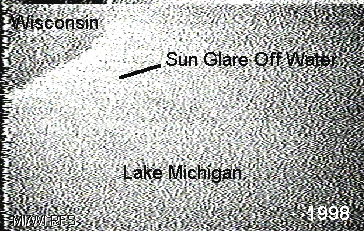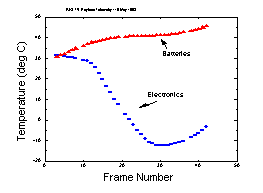TV Payload Results
Summary
Weak TV pictures and audio telemetry were received a short time
after the anticipated payload ejection. The TV camera was
consistantly aimed down, indicated some drag from the starute,
however it is clear from the video that the payload ended up
in Lake Michigan after approximately 8 or 9 minutes. The payload
was undergoing a rotation of about 1 to 2 Hz about the vertical
axis. The rotation period varied by a factor of two from
time to time, but was always in the same direction. These observations
are consistant with a failure
of the starute to deploy properly.
As the payload's altitude decreased, the images became clearer.
Some wave structure on Lake Michigan is evident just before
the signal was lost. Signals were received for just over
10 minutes from launch (8 minutes from payload ejection).
Details
At higher altitudes, the Wisconsin shoreline was seen on the edges
of the images. Later, only the lake was visible.

The following video clips are not of high quality, but give you
some idea of what was seen.
If necessary, use the "Back" button to return from the video clips.
From high up, the signal was too weak to get color, however you
can see the circular motion of the payload and on occasion you
can see the shoreline in
Video Clip 1 (4MB AVI).
Get Quicktime Movie Viewer
Farther down, the blue of Lake Michigan shows up with the bright
glare of the Sun as seen in
Video Clip 2 (3.2MB AVI).
Listen to a bit of the audio telemetry from the payload
here (489 kB, WAV) or
here (489 kB, AU).
Telemetry Data:
Thermal fuses: The lowest thermal fuse (91C) was open on descent.
The remainder were closed (121C and above). Hence, either there
was a mechanical failure of the lowest fuse, or the payload experienced
temperatures somewhat above 100C during ascent. Given that the
payload temperature after ejection was not high, exposure to temperatures
above 100C would have had to have been brief.
Battery Voltage: The battery voltage remained relatively constant
during descent, rising about 10% from just after ejection until
signal was lost. This rise is consistent with the increase in the
battery temperature. The batteries in this payload were not heat
sunk to the payload chassis. Some thermal connection between the
batteries and the chassis in the future would reduce the range of
temperatures experienced within the payload.
Temperatures:

(Each telemetry frame is approx. 10 seconds)
Return to MI/WI RFS Home Page
Return to MTU Physics Home Page


